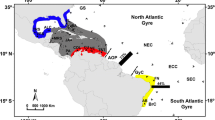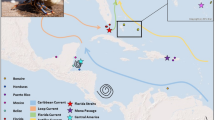Abstract
Lionfish are popular aquarium fish from the Indo-Pacific that have invaded the western Atlantic. Two species, Pterois volitans and P. miles, were well established along the United States east coast before the first lionfish were reported from the Bahamas in 2004, where they quickly dispersed throughout the archipelago by 2007. The source of the Bahamian lionfish invasion has been in question because of the hypothesized low connectivity between Florida and Bahamas reef species as well as the temporal lag in their arrival in the Bahamas. Mitochondrial control region haplotypes (680 bp) were determined and analyzed for lionfish specimens from the Bahamas, North Carolina, and two sites within their native range (Indonesia and the Philippines). Exact tests, pairwise Fst and AMOVA analyses all showed no significant differentiation between the Bahamas and North Carolina specimens. The similarity between the Bahamas and North Carolina lionfish was also reflected in a minimum spanning network and neighbor-joining distance tree generated from the data. Sequence analyses also revealed the presence of only Pterois volitans, as no P. miles were detected in the Bahamian sample. These results indicate that the source of the Bahamian lionfish is egg and larval dispersal from the United States east coast population, and support previous models of reef fish dispersal that suggest a low level of connectivity between the Bahamas and east coast of Florida.



Similar content being viewed by others
References
Briggs JC (1995) Global biogeography. Elsevier, Amsterdam
Carlin JL, Robertson DR, Bowen BW (2003) Ancient divergences and recent connections in two tropical Atlantic reef fishes Epinephelus adscensionis and Rypticus saponaceous (Percoidei: Serranidae). Mar Biol (Berl) 143:1057–1069. doi:https://doi.org/10.1007/s00227-003-1151-3
Chevalier PO, Gutierrez E, Ibarzabal D, Romero S, Isla V, Calderin J, Hernandez E (2008) First record of Pterois volitans (Pisces: Scorpaenidae) for Cuban waters. Solenodon 7:37–40
Courtenay WR (1995) Marine fish introduction in southeastern Florida. Am Fish Soc Introd Fish Sect Newsl 14:2–3
Cowen RK, Paris CB, Olson DB, Fortuna JL (2003) The role of long distance transport in replenishing marine populations. Gulf Caribb Res 14:129–137
Cowen RK, Paris CB, Srinivasan A (2006) Scaling of connectivity in marine populations. Science 311:522–527. doi:https://doi.org/10.1126/science.1122039
Excoffier L, Smouse PE, Quattro JM (1992) Analysis of molecular variance inferred from metric distances among DNA haplotypes: application to human mitochondrial DNA restriction data. Genetics 131:479–491
Excoffier L, Laval G, Schneider S (2005) Arelequin version 3: an integrated software package for population genetics data analysis. Evol Bioinform Online 1:47–50
Fishelson L (1975) Ethology and reproduction of pteroid fishes found in the Gulf of Aqaba (Red Sea), especially Dendrochirus brachypterus (Cuvier), (Pteroidae, Teleostei). Pubbl Stazione Zool Napoli 39:635–656
Freshwater DW, Khyn-Hansen C, Sarver S, Walsh P (2000) Phylogeny of Opsanus spp. (Batrachoididae) inferred from multiple mitochondrial-DNA sequences. Mar Biol (Berl) 136:961–968. doi:https://doi.org/10.1007/s002270000315
Freshwater DW, Hamner RM, Parham S, Wilbur AE (2009) Molecular evidence that the lionfishes Pterois miles and Pterois volitans are distinct species. J N C Acad Sci 125 (in press)
Guerrero KA, Franco AL (2008) First record of the Indo-Pacific red lionfish Pterois volitans (Linnaeus, 1758) for the Dominican Republic. Aquat Inv 3:255–256
Hamner RM, Freshwater DW, Whitfield PE (2007) Mitochondrial cytochrome b analysis reveals two invasive lionfish species with strong founder effects in the western Atlantic. J Fish Biol 71:214–222. doi:https://doi.org/10.1111/j.1095-8649.2007.01575.x
Hare JA, Walsh HJ (2007) Planktonic linkages among marine protected areas on the south Florida and southeast United States continental shelves. Can J Fish Aquat Sci 64:1234–1247. doi:https://doi.org/10.1139/F07-089
Imamura H, Yabe M (1996) Larval record of a red firefish, Pterois volitans, from northwestern Australia (Pisces: Scorpaeniformes). Bull Fac Fish Hokkaido Univ 47:41–46
Kimball ME, Miller JM, Whitfield PE, Hare J (2004) Thermal tolerance and potential distribution of invasive lionfish (Pterois volitans/miles complex) on the east coast of the United States. Mar Ecol Prog Ser 283:269–278. doi:https://doi.org/10.3354/meps283269
Kochzius M, Blohm D (2005) Genetic population structure of the lionfish Pterois miles (Scorpaenidae, Pteroinae) in the Gulf of Aqaba and northern Red Sea. Gene 347:295–301. doi:https://doi.org/10.1016/j.gene.2004.12.032
Maddison WP, Maddison DR (2000) MacClade 4: analysis of phylogeny and character evolution, version 4. Sinauer Associates, Sunderland
McClean JL, Poulain P-M, Pelton JW (2002) Eulerian and Lagrangian statistics from surface drifters and high-resolution POP simulation in the North Atlantic. J Phys Oceanogr 32:2472–2491
Meister HS, Wyanski DM, Loefer JK, Ross SW, Quattrini AM, Sulak KJ (2005) Further evidence for the invasion and establishment of Pterois volitans (Teleostei: Scorpaenidae) along the Atlantic coast of the United States. Southeast Nat 4:193–206. doi:https://doi.org/10.1656/1528-7092(2005)004[0193:FEFTIA]2.0.CO;2
Meyer A, Morrissey JM, Schartl M (1994) Recurrent origin of a sexually selected trait in Xiphophorus fishes inferred from a molecular phylogeny. Nature 368:539–542. doi:https://doi.org/10.1038/368539a0
Morris JA, Freshwater DW (2008) Phenotypic variation of lionfish supraocular tentacles. Environ Biol Fishes 83:237–241. doi:https://doi.org/10.1007/s10641-007-9326-2
Morris JA, Akins JL, Barse A, Cerino D, Freshwater DW, Green S, Muñoz R, Paris C, Whitfield PE (2009) Biology and ecology of the invasive lionfishes, Pterois miles and Pterois volitans. Proc Gulf Caribb Fish Inst (in press)
Nei M (1987) Molecular evolutionary genetics. Columbia University Press, New York
Nei M, Li W-H (1979) Mathematical model for studying genetic variation in terms of restriction endonucleases. Proc Natl Acad Sci USA 76:5269–5273. doi:https://doi.org/10.1073/pnas.76.10.5269
Palumbi S (1996) Nucleic acids II: the polymerase chain reaction. In: Hills DM, Moritz C, Mable BK (eds) Molecular systematics, 2nd edn. Sinauer Associates, Sunderland
Paris CB, Cowen RK, Claro R, Lindeman KC (2005) Larval transport pathways from Cuban snapper (Lutjanidae) spawning aggregations based on biophysical modeling. Mar Ecol Prog Ser 269:93–106. doi:https://doi.org/10.3354/meps296093
Raymond M, Rousset F (1995) An exact test for population differentiation. Evol Int J Org Evol 49:1280–1283. doi:https://doi.org/10.2307/2410454
Richardson PL (2005) Caribbean current and eddies observed by surface drifters. Deep Sea Res Part II Top Stud Oceanogr 52:429–463. doi:https://doi.org/10.1016/j.dsr2.2004.11.001
Roberts CM (1997) Connectivity and management of Caribbean coral reefs. Science 278:1454–1457. doi:https://doi.org/10.1126/science.278.5342.1454
Ruiz-Carus R, Matheson RE, Roberts DE, Whitfield PE (2006) The western Pacific red lionfish, Pterois volitans (Scorpaenidae), in Florida: evidence for reproduction and parasitism in the first exotic marine fish established in state waters. Biol Conserv 128:384–390. doi:https://doi.org/10.1016/j.biocon.2005.10.012
Sambrook J, Russel DW (2000) Molecular cloning: a laboratory manual, 3rd edn. Cold Spring Harbor Laboratory Press, New York
Schofield PJ, Fuller PL (2009) Pterois volitans/miles. USGS nonindigenous aquatic species database, Gainesville, FL, USA. http://nas.er.usgs.gov/queries/FactSheet.asp?speciesID=963
Schultz ET (1986) Pterois volitans and Pterois miles: two valid species. Copeia 1986:686–690. doi:https://doi.org/10.2307/1444950
Semmens BX, Buhle E, Salomon A, Pattengill-Semmens C (2004) A hotspot of non-native marine fishes: evidence for the aquarium trade as an invasion pathway. Mar Ecol Prog Ser 266:239–244. doi:https://doi.org/10.3354/meps266239
Swofford DL (2002) PAUP*: phylogenetic analysis using parsimony (*and other methods), version 4. Sinauer Associates, Sunderland
Tamura K, Nei M (1993) Estimation of the number of nucleotide substitutions in the control region of mitochondrial DNA in humans and chimpanzees. Mol Biol Evol 10:512–526
Whitfield PE, Gardner T, Vives SP, Gilligan MR, Courtenay WR, Ray GC, Hare JA (2002) Biological invasion of the Indo-Pacific lionfish Pterois volitans along the Atlantic coast of North America. Mar Ecol Prog Ser 235:289–297. doi:https://doi.org/10.3354/meps235289
Whitfield PE, Hare JA, David AW, Harter SL, Munoz RC, Addison CM (2007) Abundance estimates of the Indo-Pacific lionfish Pterois volitans/miles complex in the western North Atlantic. Biol Invasions 9:53–64. doi:https://doi.org/10.1007/s10530-006-9005-9
Acknowledgments
Participation in this study by UNCW students and Brunswick Community College faculty was supported by NSF ROA supplement award to MRI grant #0618453. Additional funding was provided by NOAA’s Invasive Species Program. Collection of North Carolina specimens was supported by UNCW’s National Undersea Research Center and NOAA. Bahamas specimens were collected with the support of REEF and Blackbeard’s Cruises. The excellent help provided by the many NURC, NOAA and REEF cruise divers is greatly appreciated and we wish to especially thank James Morris for his many efforts to facilitate our Bahamas studies. The experiments in this study complied with the current laws of the Bahamas and United States of America, and all Bahamian lionfish were collected under research permit MAF/FIS/12:MAF/FIS/17 to James Morris.
Author information
Authors and Affiliations
Corresponding author
Additional information
Communicated by M.I. Taylor.
Rights and permissions
About this article
Cite this article
Wilson Freshwater, D., Hines, A., Parham, S. et al. Mitochondrial control region sequence analyses indicate dispersal from the US East Coast as the source of the invasive Indo-Pacific lionfish Pterois volitans in the Bahamas. Mar Biol 156, 1213–1221 (2009). https://doi.org/10.1007/s00227-009-1163-8
Received:
Accepted:
Published:
Issue Date:
DOI: https://doi.org/10.1007/s00227-009-1163-8




